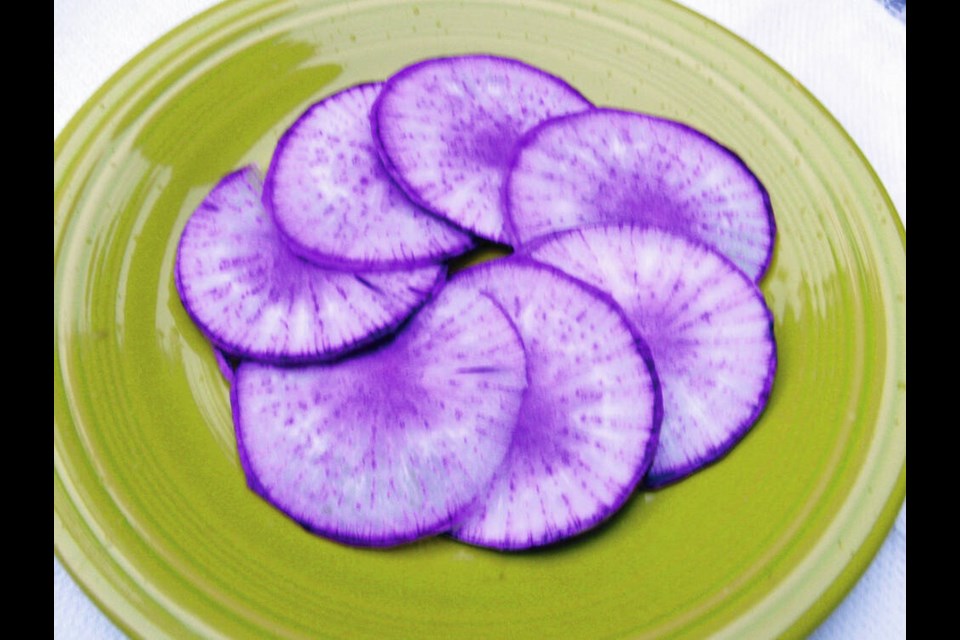One of my first outdoor seedings in the spring is a block planting of carrots and beets, in a bed 120 centimetres wide that I cover with floating row fabric secured around the perimeter. The cover lets in light and water, but bars access to the carrot rust fly and the beet leaf miner.
Routinely, all goes well. The bed keeps me well supplied with these root vegetables through the fall and most of the winter. That’s why I viewed the trashing of the carrot portion of the planting with dismay. Twice this summer, I’ve found the section of row cover over the carrots ripped up and the carrot foliage flattened to the ground.
I resurrected the carrot tops as well as I could and replaced the cover, and after the second incident I erected a patchwork of strong stakes along the path edge of the planting. So far, this protective measure has worked.
The question remains: What did this? Why flatten the carrots and not the beets? None of the carrots were unearthed or nibbled.
The pathway edging the bed runs alongside the back fence. It’s a route used periodically by neighbourhood raccoons, and I knew the raccoons were recent visitors in the garden. One evening, from the family room, I observed a raccoon saunter by, brushing against the patio doors and the back house wall.
Is it possible that one of these animals found a comfy bed atop a springy cushion of ferny foliage, with a bedsheet provided? I did not think that these and other creatures of the night would expose themselves to predators by slumbering in the open, but are any patterns long considered stable holding true any more in these topsy-turvy times?
Garden jottings. The first (end of March) seeding of shelling peas finished up last month, just as the second sowing began filling out its pods. The early vines have been composted, their site replaced with a seeding of snow peas. Fall and winter greens will replace the second pea planting when it is finished producing.
Two plantings that don’t always work well for me are a great success this year. One is a double row of greenleaf (sugarloaf) chicory, seeded in April. The rows, thinned, will yield tightly furled, romaine lettuce style heads of green and creamy white leaves that add tasty, tart notes to fall and winter salads.
The other seeding, of winter (daikon) radishes, germinated vigorously in less than a week. Last year’s June seeding fried in the high heat and blistering sun. KN-Bravo produces 15-cm-long roots with sweet, beautifully purple-flushed white flesh. Seeded alongside is Alpine, with similar roots and pure white flesh. Through the fall and winter these radishes are interesting additions, grated or cut in thin strips, to green salads. They are also tasty on their own, grated with carrot into a dressing.
Beside the daikons, seeded June 30, I sowed more carrot and beet seeds for young roots in winter. A row cover over the plantings will protect all the plants from the numerous pests that target them.
Last month’s heat sent the lettuces, endive and escarole quickly to seed, prompting a flurry of indoor seeding for replacement plants.
I harvested the first big, succulent Sweet Success cucumber two weeks ago and quickly chopped it into a blend of yoghurt, lemon juice, olive oil and mashed garlic for a cool, zesty summer salad.
At the same time I picked the first, beautiful ridged (Romanesco) Italian zucchini. On that day, a recipe appeared in the Times Colonist for a salad made with shaved zucchini, mint, basil, parmesan cheese and chopped nuts in a lemon juice and zest, olive oil and honey dressing. I had all the ingredients on hand. Sometimes, the stars do align for us.
A suggestion. Like the garlic and bulbing onions, winter squash and pumpkin plants have been delayed in their development by adverse weather earlier in the season. With last month’s warmth and sunshine, the plants have expanded nicely, but I’m checking them carefully for fruit formation.
Because fruit set has been delayed, and we’re already into August, I’ll be helping little squashes already formed to reach maturity by cutting the vine tips back, just beyond the last formed fruit, next week. This will prevent further flowering and the formation of more fruits that will have no time to mature.



